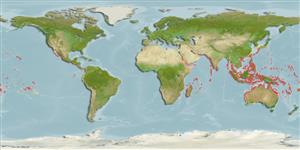Common names from other countries
Environment: milieu / climate zone / depth range / distribution range
Ecologie
; diepteverspreiding 2 - 5 m (Ref. 101327). Tropical
Indo-Pacific: from East Africa to eastern Polynesia, not in the Red Sea, the Persian Gulf, nor the Gulf of Bengal; north to Japan and Hawaii, and south to central Queensland and New Caledonia.
Length at first maturity / Size / Gewicht / Leeftijd
Maturity: Lm ? range ? - ? cm Max length : 13.0 cm SHL mannelijk/geslacht niet bekend; (Ref. 349); common length : 10.0 cm SHL mannelijk/geslacht niet bekend; (Ref. 349)
Frequently in the Indo-West Pacific for food and shellcraft (Ref. 349). Depth range is based on occurrence in French Polynesia (Ref. 101327); to be replaced with a better reference. Under stones and in crevices of rocky headlands exposed to strong wave action (Ref. 349). Usually found among dark rocks (Ref. 799). Mostly active at night. Mainly inhabits shallow subtidal levels. Occurs at the low tide mark (Ref. 349). Most cypraeids are herbivores (Ref. 113307).
Life cycle and mating behavior
Geslachtsrijpheid | Voortplanting | Kuitschieten | Eieren | Fecundity | Larven
Members of the order Neotaenioglossa are mostly gonochoric and broadcast spawners. Life cycle: Embryos develop into planktonic trocophore larvae and later into juvenile veligers before becoming fully grown adults.
Poutiers, J.M. 1998. (Ref. 349)
Status op de Rode Lijst van het IUCN (Ref. 130435)
Status bij CITES (Ref. 108899)
Not Evaluated
Not Evaluated
Gevaarlijk voor mensen
Harmless
Gebruik door de mens
Visserij: commercieel
| FishSource | Sea Around Us
Tools
Meer informatie
Leeftijd/GrootteGroeiLengte-gewicht parametersLengte-lengte parametersMorfologieLarvenAbundantie
Internet-bronnen
Estimates based on models
Preferred temperature
(Ref.
115969): 24.7 - 29.3, mean 28.4 (based on 3363 cells).
Kwetsbaarheid
Low vulnerability (10 of 100).
Prijsklasse
Unknown.
